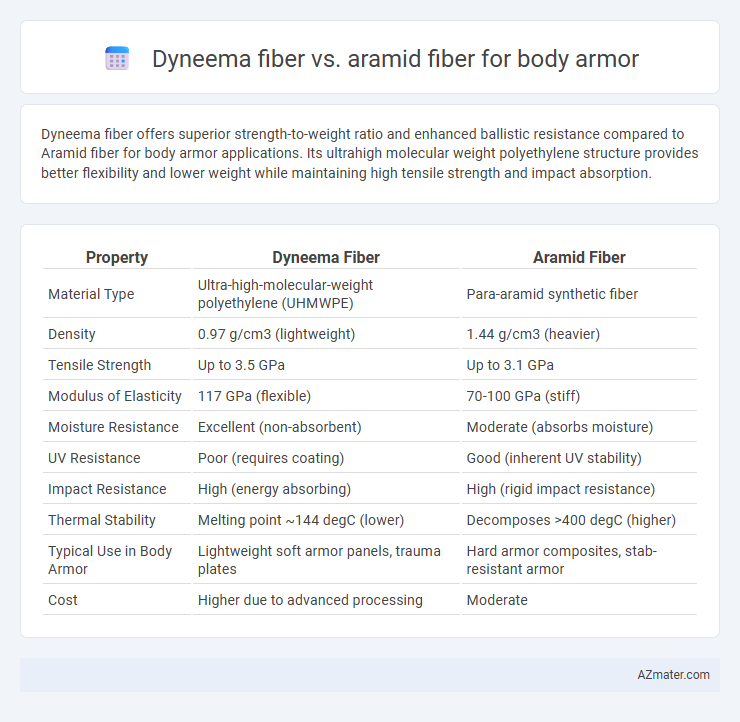Dyneema fiber offers superior strength-to-weight ratio and enhanced ballistic resistance compared to Aramid fiber for body armor applications. Its ultrahigh molecular weight polyethylene structure provides better flexibility and lower weight while maintaining high tensile strength and impact absorption.
Table of Comparison
| Property | Dyneema Fiber | Aramid Fiber |
|---|---|---|
| Material Type | Ultra-high-molecular-weight polyethylene (UHMWPE) | Para-aramid synthetic fiber |
| Density | 0.97 g/cm3 (lightweight) | 1.44 g/cm3 (heavier) |
| Tensile Strength | Up to 3.5 GPa | Up to 3.1 GPa |
| Modulus of Elasticity | 117 GPa (flexible) | 70-100 GPa (stiff) |
| Moisture Resistance | Excellent (non-absorbent) | Moderate (absorbs moisture) |
| UV Resistance | Poor (requires coating) | Good (inherent UV stability) |
| Impact Resistance | High (energy absorbing) | High (rigid impact resistance) |
| Thermal Stability | Melting point ~144 degC (lower) | Decomposes >400 degC (higher) |
| Typical Use in Body Armor | Lightweight soft armor panels, trauma plates | Hard armor composites, stab-resistant armor |
| Cost | Higher due to advanced processing | Moderate |
Introduction to Dyneema and Aramid Fibers
Dyneema fiber, also known as Ultra-High Molecular Weight Polyethylene (UHMWPE), is a lightweight, high-strength synthetic fiber renowned for its exceptional tensile strength-to-weight ratio and superior cut resistance. Aramid fibers, including brands like Kevlar and Twaron, are heat-resistant synthetic fibers characterized by excellent thermal stability, high tensile strength, and durability under ballistic impact. Both fibers are extensively used in body armor applications, with Dyneema offering enhanced flexibility and lighter weight, while Aramid provides superior heat resistance and impact absorption.
Composition and Structure Comparison
Dyneema fiber, composed of ultra-high-molecular-weight polyethylene (UHMWPE), features a linear molecular structure with exceptionally high tensile strength and low density, resulting in lightweight yet highly durable body armor materials. Aramid fibers, such as Kevlar, consist of anisotropic aromatic polyamide polymers characterized by rigid rod-like molecular chains, providing excellent heat resistance and strong tensile properties but with a higher density compared to Dyneema. The structural difference offers Dyneema superior impact energy absorption and flexibility, while Aramid fibers deliver enhanced thermal stability and cut resistance in ballistic protection applications.
Mechanical Strength and Performance
Dyneema fiber exhibits superior tensile strength, with an ultra-high molecular weight polyethylene structure providing exceptional energy absorption and lightweight durability in body armor applications. Aramid fiber, such as Kevlar, offers high thermal stability and excellent resistance to abrasion but generally has lower tensile strength compared to Dyneema. Performance-wise, Dyneema provides enhanced flexibility and blunt force trauma reduction, making it ideal for ballistic protection where weight and mobility are critical.
Weight and Comfort in Body Armor
Dyneema fiber offers significantly lower weight compared to Aramid fiber, making it an optimal choice for lightweight body armor without compromising ballistic protection. Its high strength-to-weight ratio enhances comfort by reducing wearer fatigue during extended use. Aramid fiber, although durable and heat-resistant, tends to be heavier and less flexible, which can impact mobility and comfort in body armor applications.
Ballistic Protection Capabilities
Dyneema fiber offers superior ballistic protection in body armor due to its ultra-high molecular weight polyethylene (UHMWPE) composition, providing exceptional strength-to-weight ratio and energy absorption capabilities. Aramid fibers, such as Kevlar, excel in heat resistance and tensile strength but generally weigh more and may degrade faster under UV exposure compared to Dyneema. Recent ballistic tests demonstrate that Dyneema-based armor panels achieve higher multi-hit performance and reduced trauma levels, making them preferable for lightweight, high-performance ballistic protection.
Resistance to Environmental Factors
Dyneema fiber exhibits superior resistance to moisture, UV radiation, and chemicals compared to Aramid fiber, making it ideal for body armor in harsh environmental conditions. Its high resistance to water absorption prevents degradation and maintains ballistic performance even when wet. Aramid fiber tends to weaken with prolonged exposure to UV light and moisture, reducing its durability and effectiveness over time in outdoor settings.
Flexibility and Wearability
Dyneema fiber offers superior flexibility and lightweight wearability compared to Aramid fiber in body armor applications, enhancing user mobility and comfort during extended use. Its ultra-high-molecular-weight polyethylene (UHMWPE) structure allows for thinner, more pliable armor panels without compromising ballistic protection. Aramid fibers, such as Kevlar, provide excellent strength but are heavier and less flexible, often resulting in bulkier, less comfortable body armor.
Cost and Availability
Dyneema fiber offers a lightweight and flexible option for body armor but generally comes with a higher price tag compared to Aramid fiber, making cost a significant factor in material selection. Aramid fibers, such as Kevlar, benefit from widespread manufacturing infrastructure and extensive market availability, which helps reduce expenses and ensure consistent supply for large-scale body armor production. Budget-conscious procurement typically favors Aramid fiber due to its cost-effectiveness and established distribution channels despite Dyneema's superior tensile strength and ballistic performance.
Applications in Modern Body Armor
Dyneema fiber offers exceptional tensile strength and low weight, making it a preferred choice for lightweight, flexible body armor used by military and law enforcement personnel. Aramid fibers, such as Kevlar, provide high heat resistance and excellent ballistic protection, commonly applied in helmets and rigid armor plates for enhanced durability. Modern body armor often combines both materials to optimize protection, comfort, and mobility across diverse threat environments.
Future Trends and Innovations
Dyneema fiber, known for its ultra-high molecular weight polyethylene (UHMWPE) composition, offers superior strength-to-weight ratio and enhanced blunt trauma resistance compared to traditional Aramid fibers like Kevlar. Future trends in body armor development emphasize hybrid composites combining Dyneema and Aramid materials to maximize ballistic protection while minimizing weight and bulk. Innovations include nanotechnology integration and improved resin systems to enhance fiber bonding, flexibility, and multi-threat resistance, paving the way for lighter, more durable, and ergonomically optimized protective gear.

Infographic: Dyneema fiber vs Aramid fiber for Body armor
 azmater.com
azmater.com